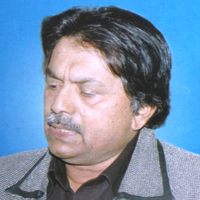Profile of Ghazanfar
ajiib baat hamārā hī ḳhuuñ huā paanī
hamīñ ne aag meñ apne badan bhigo.e the
ajib baat hamara hi KHun hua pani
hamin ne aag mein apne badan bhigoe the
Over the last forty to forty-five years, among the creators who have established their identity in various poetic and literary realms and stamped their individuality, Ghazanfar stands out as a significant, prominent, and credible name. His authorship of approximately two and a half dozen books on subjects such as short stories, novels, drama, tales, essays, sketches, ghazals, poems, masnavi, criticism, pedagogy, and linguistics reflects his vast academic and research pursuits. Simultaneously, it also highlights his consistent dedication to the fields of knowledge and literature and his creative capabilities.
Reading Ghazanfar’s works reveals that he does not prefer walking on pre-trodden paths. He avoids conventional routes in pursuit of his destination and creates his own path to continue his literary journey. It has often been observed that his quest for new directions and his innovative endeavors have been successful. He illuminates the paths he discovers so brightly that they become guiding lights for others. Whether in fiction or poetry, research or criticism, pedagogy or linguistics, masnavi or tales, sketches or autobiographies, biographies, or city chronicles, essays or drama—every form of his writings reflects, in one way or another, his inventive prowess, innovative mind, and experimental inclination. He blends traditional linguistic and literary molds with fresh hues and tones. He crafts new meanings and concepts using familiar words, drawing out novel dimensions and resonances.
Every piece of Ghazanfar’s writing is rich in creative allure and linguistic sweetness. His literary and fictional creations exude brilliance, and even his non-fictional writings carry a charm and eloquence in language and expression. Ghazanfar’s writings suggest that he pours not just sincerity and honesty into them but also his heart and soul.
Ghazanfar’s full name is Ghazanfar Ali. As a child, he was called Ashfaq Ahmad, but on the auspicious occasion of his *aqeeqah* (naming ceremony), his maternal uncle, Kitabuddin, named him Ghazanfar Ali. This became his official name. When Ghazanfar began his creative pursuits, he shortened his name to G.A. and added Ghazanfar at the end, becoming G.A. Ghazanfar. Consequently, his early creations were published under this name. His first drama, *Koyle Se Heera* (Coal to Diamond), was also published as G.A. Ghazanfar. When he reached his Master’s program, on a friend’s suggestion, he changed his name to Ghazanfar Ali Ghazanfar. His first critical book, *Mashriqi Meyar-e-Naqd* (Eastern Standards of Criticism), also bore this name. Later, when his ghazals were published in the journal *Shabkhoon*, Shamsur Rahman Faruqi suggested removing “Ghazanfar Ali” from his name, remarking, “One Ghazanfar is enough,” simplifying his three-word name to one. Ghazanfar appreciated this modification and adopted it as his pen name and pseudonym.
The renowned humorist Mujtaba Hussain once commented beautifully on this concise name in the preface of Ghazanfar’s second collection of sketches, *Roo-e-Khush Rang*:
“Ghazanfar’s writings have a unique charm, and even his name carries a singularity. I have never heard such a concise name. Generally, admirers remember writers and poets by part of their names, but on books, their full names are written. Ghazanfar’s abbreviated name doesn’t diminish his stature; rather, it elevates it.”
Ghazanfar was born on March 9, 1953, in the village of Chaurawn, district Gopalganj, Bihar. His mother’s name was Daroodan Khatoon, a homemaker who stayed in the village with her children. His father, Abdul Mujeeb, worked in Kolkata, where he passed away.
Ghazanfar’s mother wanted him to pursue education and become successful but also desired he first acquire religious knowledge to secure his afterlife. Thus, he was enrolled in a madrasa for religious studies. Although he developed a deep interest in religion, the strict and dry environment of the madrasa did not suit him. He frequently found excuses to escape the madrasa and eventually quit. His mother then enrolled him in a local school, where he excelled academically and became a favorite among his teachers.
Ghazanfar has referred to this phase in his poem *Miyan Tum Hi Ghazanfar Ho* (You Are the Same Ghazanfar). Though he did not fully appreciate his mother’s aspirations then, he later regretted not living up to her dreams during her lifetime. He expressed this regret poignantly in another poem.
Ghazanfar’s academic journey began with religious education but soon transitioned to secular schooling, where he flourished. He completed his middle and high school education with outstanding performance, ultimately choosing Arts over Science despite initial familial expectations of him becoming a doctor. His success in this decision vindicated him when he excelled in his board exams.
After high school, Ghazanfar pursued his Bachelor’s degree at Gopalganj College and later enrolled in Bihar University, Muzaffarpur, for his Master’s in Urdu. Due to the Jayaprakash Narayan movement, the university was shut down. He then managed to secure admission to Aligarh Muslim University’s Urdu department with a friend’s help.
At AMU, he completed his M.A. in Urdu with distinction in 1976, earning a university medal. He pursued a Ph.D. on Shibli Nomani’s critical theories, completing it in 1982. During his academic journey, Ghazanfar received Junior Research Fellowships, scholarships from the Uttar Pradesh Urdu Academy, and teaching assignments in the Urdu department. Under the mentorship of renowned teachers like Khursheed-ul-Islam, Khalil-ur-Rahman Azmi, Shahryar, and Qazi Abdus Sattar, his creative talents flourished.
He became widely recognized as both a poet and a short-story writer, served as the secretary of *Urdu-e-Moalla*, and joined the editorial board of *Aligarh Magazine*. His journey in literature and academia was marked by creativity, innovation, and a deep commitment to his craft.
Tagged Under
Authority Control :The Library of Congress Control Number (LCCN) : n88161416

